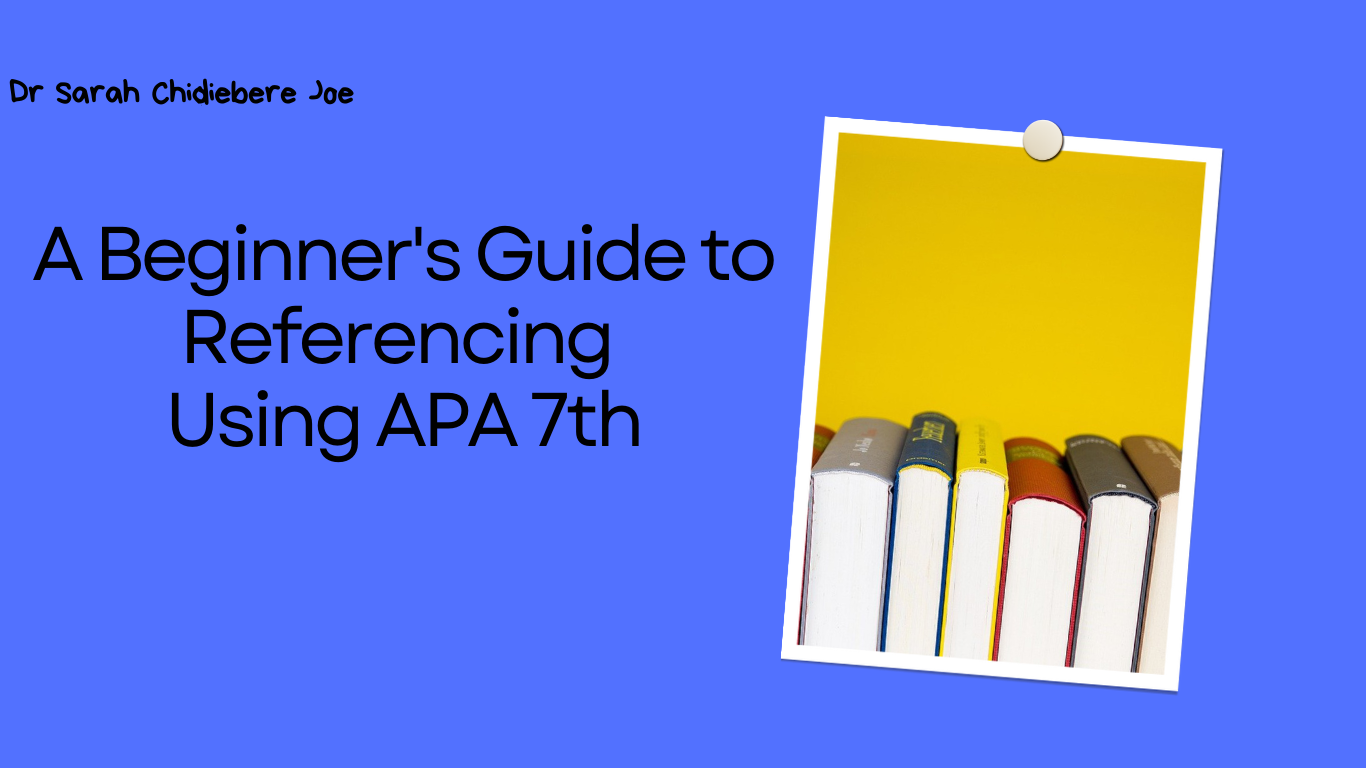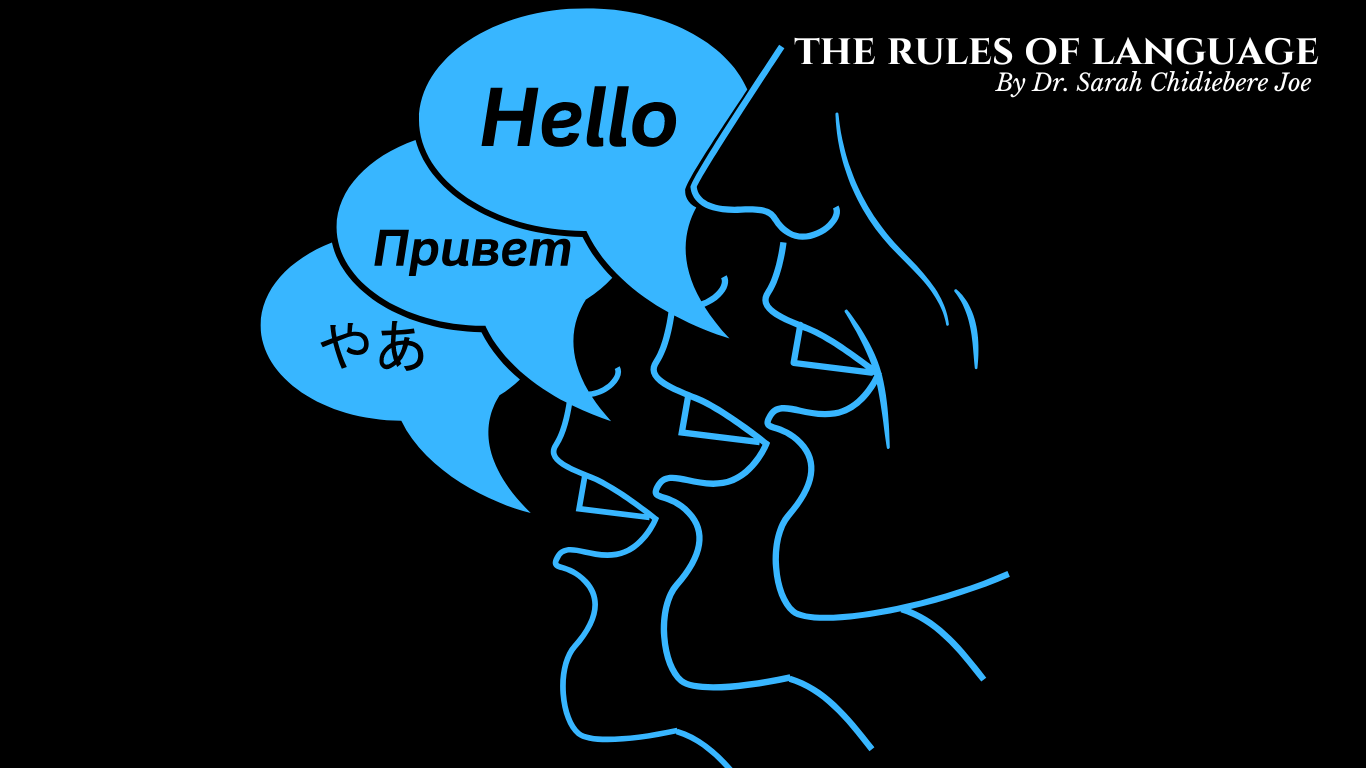BY: Dr. Sarah Chidiebere Joe
Introduction to Referencing
Referencing is an academic exercise that entails giving credit to, and recognising the sources of one’s ideas and thoughts when writing. Academics credit sources within the body of their publications in what is called IN-TEXT CITATION. They also draw up a list of all the sources cited in their work at the end. This is called a REFERENCE LIST and is usually presented in alphabetical order.
An in-text citation is composed of the author’s name and date when the material was published, while the reference list provides complete information including the title and publisher of the cited material.
In referencing, the general rule is to mention sources when the following are included in a piece of writing:
- theories, facts, arguments, perspectives/viewpoints that are attributable to a person, group or organisation;
- data/statistics and case studies;
- illustrations and other forms of visual materials; and
- musical texts.
Information that are regarded as Common knowledge, that is, information known by all or nearly everyone, needs not be referenced. For example, it is common knowledge that Port Harcourt is the capital of Rivers State, Nigeria. It is also common knowledge that Football is the most popular sporting activity in the world.
Although there are many referencing conventions, this guide is dedicated to the use of the 7th edition of the American Psychological Association (APA) referencing format. The APA format eases comprehension of written texts and is, therefore, preferred in disciplines such as psychology, sociology, history and communication, where scholars do a lot of writing.
Also note that:
- Referencing needs to be consistent throughout a piece of writing.
- Provide more rather than less information if in doubt.
- Take note of details regarding any source of information that you use immediately as locating them later may prove really difficult and time consuming.
- Titles and Subtitles are separated using a Colon followed by a Space.
- Include the edition numbers except for the first edition.
- Use p. and pp. for a single and multiple page numbers, respectively.
- Separate each citation with a semicolon. For example, (Joe, 2019; Joe & Ette, 2019).
- When citing different works by an author published in the same year, distinguish them by including letters to the year of publication. For example, (Agbiboa, 2014a, 2014b).
- Use URL shortening devices such as Bitly or TinyURl to reduce the length of URLs.
- A reference list is located at the end of a piece of work.
- The reference list must be placed in alphabetical order using the author’s surname.
- Use single spacing, not double between each source.
- Your reference list should not be indented.
Sample Reference List
Azumah, J. (2015). Boko Haram in retrospect. Islam and Christian-Muslim Relations, 26(1), 33-52. doi:10.1080/09596410.2014.967930.
Babalola, D. (2014). The underdevelopment of Nigeria’s Niger Delta: Who is to blame? Journal of Sustainable Development, 7(3), 118-128.
Barthes, R. (1981). Camera Lucida. Hill & Wang
Carragee, K. M. & Roefs, W. (2004). The neglect of power in recent framing research. Journal of Communication 54(2): 214–233.
Why Reference?
Authors reference for many reasons including:
- To demonstrate scholarship – that one has read widely, located relevant material, and is conversant with literature in a particular subject or field.
- To support one’s line of argument made based on citing an authority in a subject area.
- To give readers the option to locate and verify the origin of a writer’s ideas and thoughts, and, therefore, be able to read and make up their own minds.
- Good and accurate referencing is a key criterion for successfully completing an academic writing exercise or programme. Academics who fail to reference sources can be accused of plagiarism, that is, taking people’s ideas without acknowledgement. Failing to reference is regarded as an Academic Misconduct.
Elements of the Reference List and In-Text Citation
The art of referencing involves responding to four main questions about the sources and materials cited in a piece of writing. These questions include the WHO, WHEN, WHAT, and WHERE. The Who question addresses the author of the work, while the When refers to the time/period of publication. The What and Where deal with the title of the published work and where this work can be located, respectively.
The in-text reference focuses on only two of these questions, the WHO and the WHEN. When applying in-text citations, note the following:
- include the author’s surname and year of publication. For example, Joe (2019).
- when referencing two authors inside brackets, use an ampersand (&) to link the surnames of both authors, e.g. (Joe & Ette, 2018).
- when mentioning titles of books, publications, compositions, movies in a piece of academic writing, apply italics and capital letters for each key word. For example, A Thousand Plateaus.
Quotes, Paraphrases and Summaries
Quotes are portions of text directly copied from an original source. They are placed between double quotation marks (“) if the number of words is less than 40 and indented if more than 40 words. In APA 7th, writers are required to include the author’s name, year of publication, and page number. For example:
Less than 40 words – The authors argued that the murder of Yusuf and the use of brute force against members “intensified the belligerence” of the notorious group (Onapajo, Uzodike & Whetho, 2012, p. 24).
More than 40 words – In describing the nature of the Nigerian media, the author said:
Legacy media outlets in Nigeria are backed by law and play the normative functions of informing, educating, and entertaining the Nigerian public as well as hold the Nigerian government accountable to citizens. In addition to print and broadcast media, the Internet and Internet-enabled platforms offer additional/alternative sources of media engagement for Nigerians (Joe, 2020, p. 27).
Paraphrases entail putting a section of an original text or thought in one’s own words. Although the text has been rewritten, writers who paraphrase are required to credit their source. It is also advisable to include the page number/location of the text. For example:
Studies have shown that social media platforms are prone to ideological polarization (Dylko et al., 2017; Stroud, 2010).
Summarising a source means providing a general understanding about an entire piece of work rather than on a particular aspect of the text. In this instance, writers are not required to include page numbers.
Secondary Referencing
Secondary referencing occurs when writers cite an author’s work that they have not directly read but was mentioned by another author whose work they have read. The APA recommends that writers “use secondary sources sparingly, for instance, when the original work is out of print, unavailable through usual sources, or available only in a language that you do not understand” (American Psychological Association, 2020, p. 258).
To cite a secondary source:
- cite the author and year of publication (if known) of the original source followed by the citation for the secondary source.
For example:
- Okon (as cited in Joe, 2004, p. 34) averred that …
- (ii) In line with Siebert, Patterson and Schramm’s (1956) argument that the press “takes on the form and colouration of the social and political structures within which it operates” (as cited in Ette, 2000, p. 67),
- On the reference list, include complete details about the secondary source, not the primary. For instance:
- Ette, M. (2000). Agent of change or stability? The Nigerian press undermines democracy. Press/Politics, 5(3), 67-86.
Missing Information
In some cases, relevant information for proper citation using the APA may be missing. Authors in these instances are advised to seek other sources. However, here are some steps to take if the source with missing information is deemed very important. Here’s what to do:
A. If the Author information is missing, include the title, date and source:
- Italicise the title if it is italicised in the reference list, e.g. book or artwork. For example:
- This image creates a feeling of happiness (Sunflower, 2019) – (In-text citation)
- Sunflower [Photograph]. (2019). https://unsplash.com/photos/vK NjdRBqep0 – (Reference list)
- Enclose the title in quotation marks if the title is not italicised in the reference list, e.g. a journal article. For example:
- The gardening advice provided (“Sunflowers require a sunny spot”, 1989) – (In-text)
- “Sunflowers require a sunny spot.” (1989). Gardening for Beginners, 4(Spring). p. 32 – (Reference list)
B. If the Date of publication is missing, include author, substitute n.d. for no date, and then give title and source. For example:
- (Smith, n.d.) – (In-text)
- Smith, S. (n.d.). Sunflower [Photograph]. https://unsplash.com/photos/vK NjdRBqep0 – (Reference list)
3. If the Title of the publication is missing, include author and date, describe document inside square brackets, and then give source. For example:
- (Smith, 2019) – (In-text)
- Smith, S. (2019). [Photograph of sunflower] https://unsplash.com/photos/vK NjdRBqep0 (Reference list)
In-text Citation Guide For Different Number of Authors
| Number of Authors | First in-text citation | Subsequent mentions |
| One author | According to Joe (2020), on Twitter, where the constellation of users comprises both established media sources and ordinary people OR …(Joe, 2020). | Same |
| Two authors | Okon and Joe (2021) recommend… OR … (Okon & Joe, 2021). | Same |
| Three or more authors | Joe et al. (2021) describes … OR … (Joe et al., 2021). | Same |
| Organisation with an acronym | The Economic and Financial Crimes Commission (EFCC, 2019) reported… OR …(Economic and Financial Crimes Commission [EFCC], 2019) | The EFCC (2019) reported … OR … (EFCC, 2019). |
| Unknown | Cite the title in place of the author. The Handbook on Being Elan (2020) stated that… OR … (The Handbook on Being Elan, 2020). | Same |
Reference List Guide For Different Number of Authors
| Number of Authors | Example of names at the start of reference |
| Up to twenty authors list them all and use an ampersand before the final author’s name | Okon, G. B., Amadi, F., Amadi, R., Nsereka, B. G., Itieke, H., Umor, E., & Ngochindo, G. (2019). |
| Twenty one or more authors – include the first 19 authors’ names, insert … (3 dots called an ellipsis) no ampersand, and then add the final author’s name. | Kalnay, E., Kanamitsu, M., Kistler, R., Collins, W., Deaven, D., Gandin, L., Iredell, M., Saha, S., White, G., Woollen, J., Zhu, Y., Chelliah, M., Ebisuzaki, W., Higgins, W., Janowiak, J., Mo, K. C., Ropelewski, C., Wang, J., Leetmaa, A., … Joseph, D. (1996). |
| Organisation – write full name not acronym | National Health Service (2019). |















